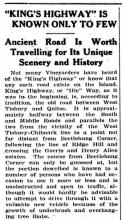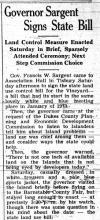Members of the Martha’s Vineyard Commission heard last week about a comprehensive new effort to lessen the number of cars on Island roads and make sure that those roads maintain their rural character.
In order to solve the Island’s traffic troubles and preserve its country feel, the MVC must embrace a plan and aggressively seek federal funds for two goals, they were told: establishing a system for reducing the number of cars on Island roads and rewriting government standards for road construction, at least as they apply to the Island.
Craig Whitaker and Dan Greenbaum, two longtime summer residents who also happen to be respected planners, presented commissioners with a 12-page report, the culmination of two years of study of traffic issues. They urged commissioners to review their proposal and embrace it, after making any additions or corrections that they see fit.
Their project needs endorsement from a regional public body, they said, in order to be taken seriously by the people who dispense federal grant money.
“There needs to be a political consensus that there is a problem,” Mr. Whitaker said. “It’s called putting forward a face.”
Commissioners offered a variety of reactions. Some were confused about the need for more study of traffic problems, especially as they were outlined on a series of cardboard boards that Mr. Whitaker and Mr. Greenbaum used as visual aids.
“We’ve done studies,” said commissioner Phil Smith. “We’ve studied the studies. We’ve studied the studies of the studies, then we hired somebody last year to go and study the studies again. How do we move this forward to implementation? I gather from your boards that we need to do more studies.”
But Linda Sibley, chairman of the commission, disagreed.
Mrs. Sibley, who sat in on some of the preliminary meetings on the issue with Mr. Whitaker, Mr. Greenbaum and others, said that part of what’s needed now are studies of the potential solutions. For example, if the Island wants a better system of mass transit, it needs to come up with a specific proposal, compile cost estimates and really examine the feasibility of the proposed system.
“We have studied and studied,” she said. “But we have studied the problem. What they are saying is now we need to study the solutions.”
There are two basic areas that need to be addressed, Mr. Whitaker and Mr. Greenbaum said: designing an alternate transportation system and creating new standards for rural roads.
They noted that a recent transportation system report by Catherine Donaher and Associates was an excellent first step. But the report stopped when it reached the area of possible solutions to the car problem. The various solutions that were suggested -- such as a jitney system or a water taxi system -- need to be examined. The Island must find out how much each one would cost, whether it would really reduce car traffic, who would use it and who would object to it.
In regard to saving the character of rural roads, Mr. Whitaker and Mr. Greenbaum noted that the problem, up to now, has been that the Island’s roads are designed according to state standards. The result has been heavy guardrails and reflector lights on roads that have always been simple rural roads.
What the Island must do is come up with a set of alternate standards, specific to Island needs, they said. Mr. Whitaker showed slides of rural roads that exist in national parks on the West Coast, which were built according to specific rural standards that are more aesthetically pleasing than the city standards, but just as safe.
Most important, in developing any recommendation, the Island must establish that there is consensus. Without that, it will be hard to win funds.
Nevertheless, Mr. Whitaker said he believes it’s possible. He pledged to bring the project to every board of selectmen on the Island several times. He also told commissioners that the Island has come a long way in terms of finding consensus on traffic. He recalls having a meeting on the issue at the beginning of his study process with a diverse group of Island leaders. Among them were Randi Vega, executive director of the Martha’s Vineyard Chamber of Commerce, and Brendan O’Neill, executive director of the Vineyard Conservation Society.
They agreed on many issues that day, he said.
“It’s not a likely combination,” he said. “I have great respect for both of them, but that’s not the kind of consensus I would have thought possible 10 years ago or 15 years ago.”
Commissioners said they will take the matter under advisement and address it at their next meeting.









Comments